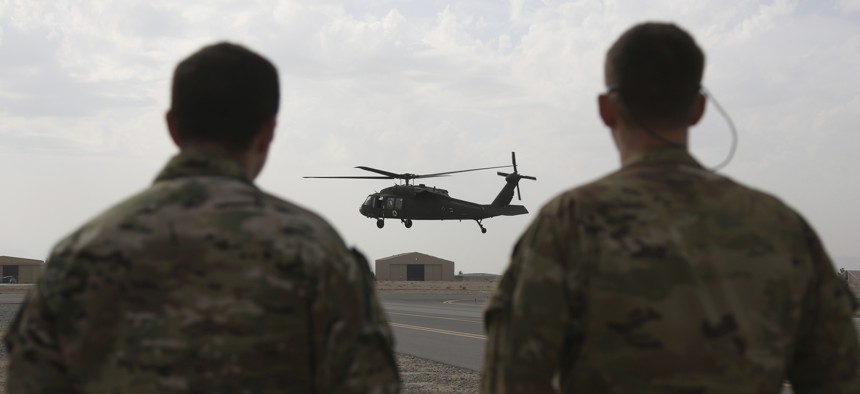
In this Monday, March 19, 2018 photo, a UH-60 Black Hawk helicopter carrying US advisers and Afghan trainees takes off at Kandahar Air Field, Afghanistan. AP Photo/Rahmat Gul
To End America’s War in Afghanistan, US Troops Can’t Leave Yet
Walking away out of frustration — especially during peace talks — is as empty a strategy as doubling down out of optimism.
America’s endless war in Afghanistan is ending as peace talks inch forward and our Afghan allies take on their own fight. As a diplomat, I know that the way we exit is key to the right ending — and never having to return.
When I first served as a diplomat at the U.S. Embassy in Afghanistan, from 2009 to 2010, our force levels were on the rise and we were indisputably at war. International troops were dying almost every day. We pushed large amounts of well-intentioned funding to a population still under the thumb of powerful warlords.
I returned to Kabul as the deputy to the U.S. ambassador, second in command at the embassy, from 2017 to 2018. By then, our Afghan counterparts had control of national and local governments, the economy, and the military. Our assistance had become more targeted. Afghan opinion strongly supported girls attending school and women served in the president’s Cabinet. The civil service stocked its ranks through a competitive exam and a generation of Afghans has emerged during this fragile rebuilding period. These young leaders impressed me with their intention to change their country’s self-defeating dynamic of civil war.
Current U.S. expenditures in Afghanistan, including support for our embassy, development and rule of law assistance, and military costs, are now half the size they were five years ago and headed in the right direction: downwards.
Related: The Taliban Got Way Deadlier in 2019, Says Pentagon's Afghanistan IG
Related: Escalating the US Air War in Afghanistan Isn’t Working
Related: Who Gets to Tell the Story of the Afghanistan War?
It’s the Afghans’ war now. Although U.S. military and intelligence operatives continue counterterrorism operations, large-scale U.S. combat operations ended in 2014, and we now are managing a handover. One U.S. military death is one too many, but there were 13 American combat deaths in Afghanistan in all 2018, compared to 53 in a single terrible month (October 2009) during my first tour. The 2019 National Defense Authorization Act’s report to Congress says that in 2017, worldwide, 80 U.S. service members died in noncombat training-related accidents compared to 21 in combat. Afghan military leaders for several years have taken on strategic planning and battlefield execution, Afghan families are supporting their troops and bearing the burden of their deaths in battle, and the Afghan government is planning for a political solution that will bring real peace and security.
Related: Who Gets to Tell the Story of the Afghanistan War?
Related: How Does This War End? Afghanistan Endgame, Part 2
Is there still an insurgency and a threat of terrorist violence? Yes. Cowardly attacks on soft targets continue, and the Afghan population suffers. When I lived in Kabul, Afghan colleagues told me they say goodbye to their families carefully each morning before going to work, because they know it might be the last time.
Rather than relying on the international community, Afghan citizens’ faith is in the Afghan security forces, which now number more than 250,000, including special forces and elite police response teams. Afghan security forces protect the institutions vital to the constitutional rights of women and men, and these patriots are in the fight. Afghan soldiers and police, not U.S. forces, repel Taliban attacks on checkpoints and government offices and guarding against ISIS attacks on schools and mosques. When heavily armed assailants tried to take over a training site in the heart of Kabul in 2018, the Afghan security forces’ Crisis Response Unit, with help from Norwegian trainers and the United States mentors, conducted the response.
We want to use our tools of diplomacy and development, but these cannot succeed in a security vacuum fueled by neighboring safe havens and empowered criminals. As a diplomat, it is clear to me that continued U.S. military support to Afghan security forces is essential during the period in which a peace framework is negotiated.
Recent Washington Post reporting shows how our political, national security, and military leaders often were too optimistic about this uniquely difficult conflict. Our attempts to help rebuild Afghanistan and our failures over the years are amply documented. There are patterns we don’t want to repeat. We made national security decisions overlaid with our domestic politics, setting and reversing strategies based on our own electoral cycles, without full regard for the Afghan realities and lessons from history.
I know this first-hand; in 2009, during the new Obama administration’s strategy review, I worked on my ambassador’s classified (and subsequently leaked) unsuccessful position in which he argued against a troop surge and warned of the Afghan leadership’s weaknesses.
Walking away out of frustration is just as empty a strategy as doubling down out of optimism. Even as we acknowledge our blind spots and mistakes, the United States should remain engaged in Afghanistan to see the peace process through.
Abrupt withdrawal of our support and presence would jeopardize Afghanistan’s extraordinary gains since 2001, made with our assistance, and risk making a still-volatile security landscape even more dangerous for the Afghan people and the world. In Western Europe, the Balkans, Colombia, and elsewhere, the United States has successfully used its instruments of national power to help stabilize volatile post-conflict situations. Doing so in Afghanistan in particular means continuing to help their security forces through an orderly transition period, while democratic institutions and the economy get stronger.
By doing this we will have helped avoid a return to the civil war that prompted our intervention in the first place. And we can agree that once we close the chapter in Afghanistan, we never want to re-open it again.
The opinions and characterizations in this piece are those of the author and do not necessarily represent those of the U.S. government.
NEXT STORY: The US Navy Needs More Pete ‘Maverick’ Mitchells




